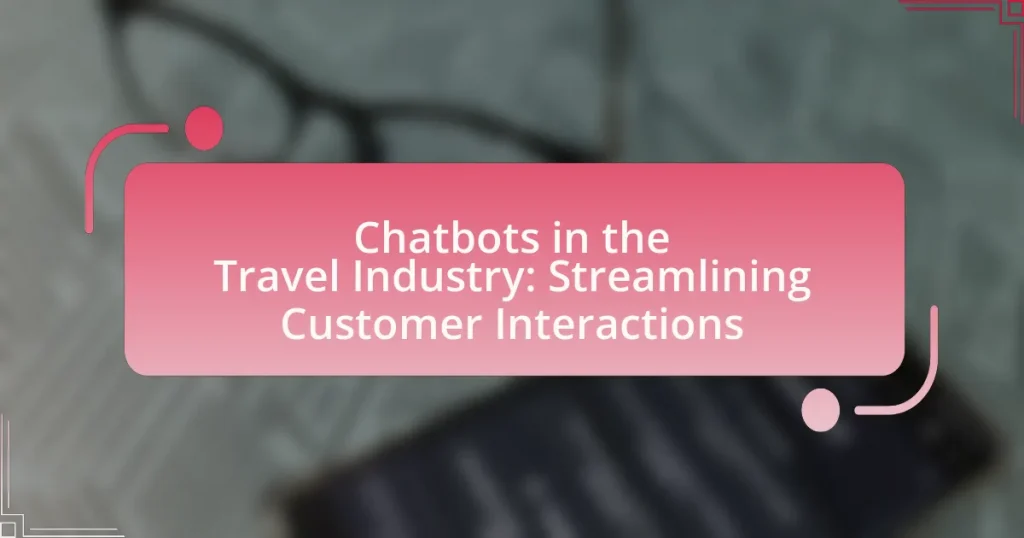Chatbots in the travel industry are automated software applications that enhance customer interactions by providing instant responses, booking assistance, and personalized travel recommendations. Utilizing artificial intelligence and natural language processing, these chatbots improve customer service efficiency, offering 24/7 support and reducing operational costs. The article explores the various functions of chatbots, their impact on customer satisfaction, the types of chatbots used, and the challenges faced in their implementation. Additionally, it highlights the advantages of AI-driven chatbots over rule-based systems and discusses best practices for effective deployment in the travel sector.
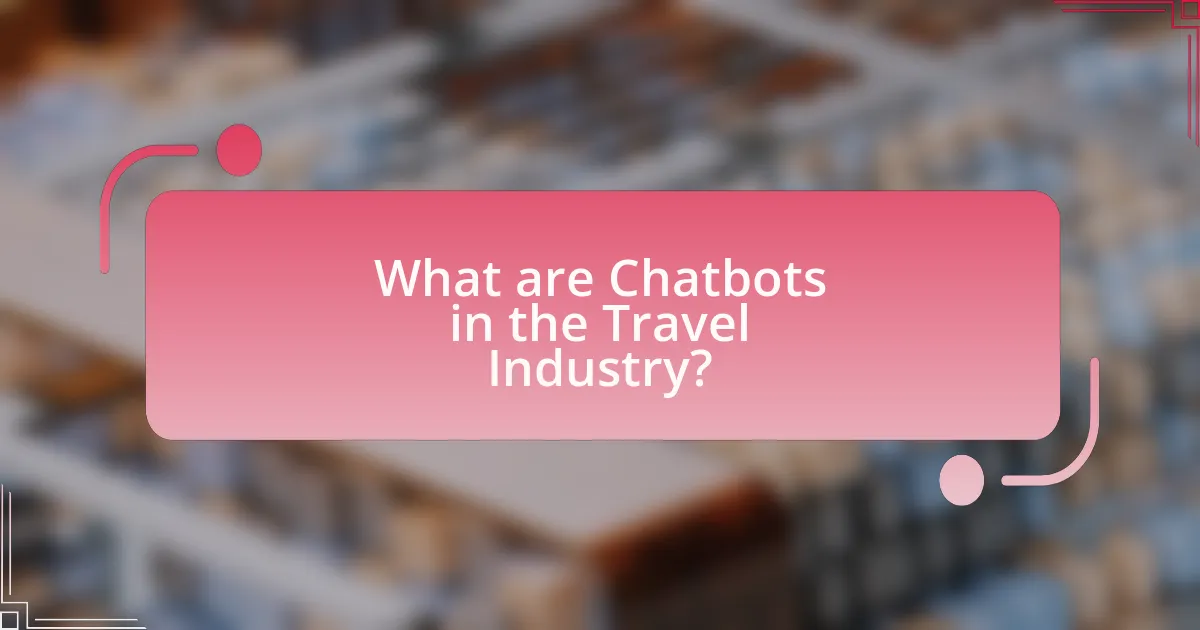
What are Chatbots in the Travel Industry?
Chatbots in the travel industry are automated software applications designed to facilitate customer interactions by providing instant responses to inquiries, booking assistance, and personalized travel recommendations. These chatbots utilize artificial intelligence and natural language processing to understand and respond to user queries effectively. According to a report by Statista, the global chatbot market in the travel sector is projected to reach $1.34 billion by 2024, highlighting their growing importance in enhancing customer service and operational efficiency.
How do Chatbots enhance customer interactions in travel?
Chatbots enhance customer interactions in travel by providing instant support and personalized experiences. They facilitate 24/7 availability, allowing travelers to receive assistance at any time, which is crucial for addressing urgent inquiries such as flight changes or booking issues. According to a study by IBM, businesses that implement chatbots can reduce customer service costs by up to 30%, demonstrating their efficiency in handling high volumes of inquiries. Additionally, chatbots can analyze user data to offer tailored recommendations, improving customer satisfaction and engagement. This capability is supported by research from the Travel Technology Association, which found that 70% of travelers prefer using chatbots for quick answers over traditional customer service methods.
What specific functions do Chatbots perform for travelers?
Chatbots perform several specific functions for travelers, including providing instant customer support, facilitating bookings, offering personalized travel recommendations, and delivering real-time updates on travel itineraries. These functions enhance the travel experience by ensuring that travelers have access to information and assistance at any time. For instance, a study by the Travel Technology Association found that 70% of travelers prefer using chatbots for quick inquiries, demonstrating their effectiveness in improving customer interactions in the travel industry.
How do Chatbots improve response times for customer inquiries?
Chatbots improve response times for customer inquiries by providing instant, automated replies to frequently asked questions. This capability allows businesses to handle multiple inquiries simultaneously without the delays associated with human agents. For instance, a study by IBM found that chatbots can reduce response times by up to 80%, enabling customers to receive immediate assistance 24/7. By utilizing natural language processing, chatbots can understand and respond to customer queries accurately, further enhancing efficiency in customer service interactions.
Why are Chatbots becoming essential in the travel sector?
Chatbots are becoming essential in the travel sector due to their ability to provide instant customer support and streamline booking processes. They enhance user experience by offering 24/7 assistance, which is critical in an industry where customers often seek immediate answers regarding travel arrangements. According to a report by Statista, 69% of consumers prefer chatbots for quick communication with brands, highlighting their effectiveness in addressing customer inquiries efficiently. Additionally, chatbots can handle multiple queries simultaneously, reducing wait times and improving overall service efficiency, which is vital in a fast-paced travel environment.
What challenges do traditional customer service methods face?
Traditional customer service methods face challenges such as limited availability, slow response times, and inconsistent service quality. These methods often rely on human agents who may not be available 24/7, leading to delays in addressing customer inquiries. According to a study by Microsoft, 66% of consumers expect businesses to understand their needs and expectations, which traditional methods struggle to meet consistently due to varying agent performance and knowledge. Additionally, the reliance on phone and email communication can result in longer wait times, frustrating customers who seek immediate assistance.
How do Chatbots address these challenges effectively?
Chatbots effectively address challenges in the travel industry by providing instant responses to customer inquiries, thereby reducing wait times and enhancing user satisfaction. They utilize natural language processing to understand and respond to a wide range of questions, which allows for 24/7 customer support without the need for human intervention. For instance, a study by Juniper Research indicates that chatbots can handle up to 80% of routine inquiries, significantly decreasing the workload on human agents. Additionally, chatbots can personalize interactions by analyzing user data, leading to tailored recommendations and improved customer experiences. This capability not only streamlines communication but also increases operational efficiency for travel companies.
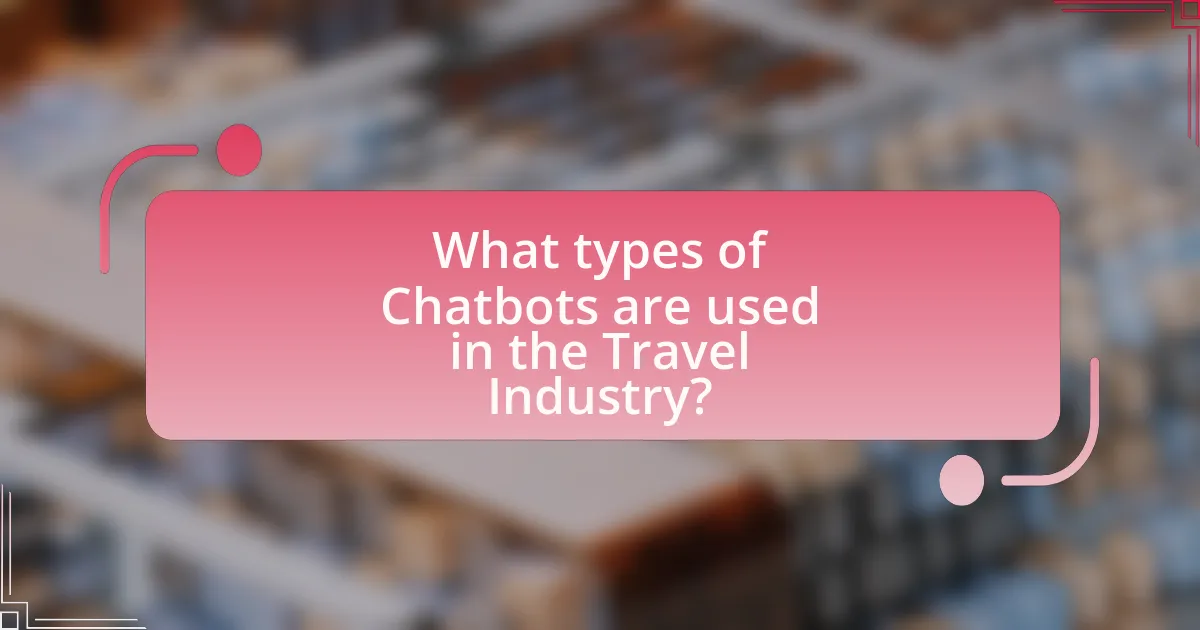
What types of Chatbots are used in the Travel Industry?
The types of chatbots used in the travel industry include informational chatbots, transactional chatbots, and customer service chatbots. Informational chatbots provide users with travel-related information such as destination details, flight schedules, and hotel availability. Transactional chatbots facilitate bookings and payments, allowing users to reserve flights, accommodations, and activities directly through the chat interface. Customer service chatbots assist travelers with inquiries, changes to bookings, and troubleshooting issues, enhancing the overall customer experience. These chatbots leverage natural language processing to understand and respond to user queries effectively, streamlining interactions and improving efficiency in the travel sector.
How do rule-based Chatbots differ from AI-driven Chatbots?
Rule-based chatbots operate on predefined rules and scripts, while AI-driven chatbots utilize machine learning and natural language processing to understand and respond to user queries. Rule-based chatbots can only handle specific commands and scenarios, limiting their flexibility and adaptability. In contrast, AI-driven chatbots learn from interactions, allowing them to provide more personalized and context-aware responses. For instance, a study by Gartner indicates that by 2025, 75% of customer interactions will be powered by AI, highlighting the growing reliance on AI-driven solutions for enhanced customer engagement.
What are the advantages of using AI-driven Chatbots in travel?
AI-driven chatbots in travel provide enhanced customer service, 24/7 availability, and personalized experiences. These chatbots can handle a high volume of inquiries simultaneously, reducing wait times and improving customer satisfaction. According to a study by Juniper Research, chatbots are expected to save the travel industry $2.95 billion annually by 2023 through operational efficiencies. Additionally, AI chatbots can analyze customer data to offer tailored recommendations, increasing the likelihood of bookings and customer loyalty.
In what scenarios are rule-based Chatbots more effective?
Rule-based chatbots are more effective in scenarios with structured interactions and predictable queries. These chatbots excel in handling frequently asked questions, such as booking confirmations, itinerary changes, and basic customer service inquiries, where responses can be predefined. For instance, in the travel industry, a rule-based chatbot can efficiently manage tasks like providing flight status updates or answering questions about baggage policies, as these scenarios involve specific, consistent information that does not require complex understanding or contextual awareness. The effectiveness of rule-based chatbots in these situations is supported by their ability to deliver quick, accurate responses, reducing wait times and improving customer satisfaction.
What are the key features of effective travel Chatbots?
Effective travel chatbots possess several key features that enhance customer interactions. Firstly, they offer 24/7 availability, allowing travelers to access assistance at any time, which is crucial in the travel industry where time zones and urgent inquiries are common. Secondly, they provide personalized recommendations based on user preferences and past interactions, improving user satisfaction and engagement. Thirdly, effective travel chatbots integrate with various booking systems, enabling seamless transactions and real-time updates on flight statuses, hotel availability, and itinerary changes. Additionally, they utilize natural language processing to understand and respond to user queries in a conversational manner, making interactions more intuitive. Lastly, they can handle multiple languages, catering to a diverse customer base and enhancing accessibility. These features collectively contribute to a more efficient and user-friendly travel experience.
How does natural language processing enhance user experience?
Natural language processing (NLP) enhances user experience by enabling chatbots to understand and respond to customer inquiries in a conversational manner. This capability allows for more intuitive interactions, as users can communicate in natural language rather than relying on rigid command structures. For instance, a study by Accenture found that 63% of consumers prefer to use messaging apps for customer service, highlighting the demand for seamless communication. Additionally, NLP facilitates personalized responses by analyzing user data and context, which improves satisfaction and engagement. By automating responses to frequently asked questions, NLP also reduces wait times, further enhancing the overall user experience in the travel industry.
What role does personalization play in Chatbot interactions?
Personalization significantly enhances chatbot interactions by tailoring responses to individual user preferences and behaviors. This customization leads to improved user satisfaction, as chatbots can provide relevant information and recommendations based on past interactions or user data. For instance, a study by Salesforce found that 70% of consumers say a company’s understanding of their personal needs influences their loyalty. By leveraging personalization, chatbots can create a more engaging and efficient experience, ultimately driving customer retention in the travel industry.
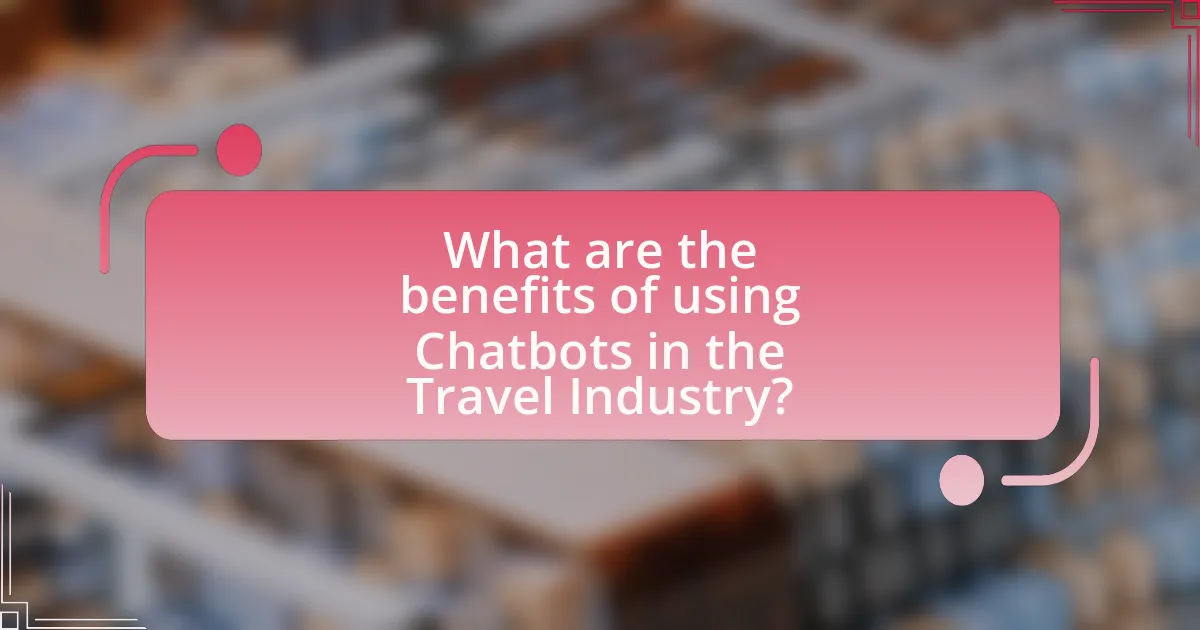
What are the benefits of using Chatbots in the Travel Industry?
Chatbots in the travel industry provide numerous benefits, including enhanced customer service, 24/7 availability, and cost efficiency. These automated systems can handle a high volume of inquiries simultaneously, allowing travel companies to respond to customer questions and issues promptly. For instance, a study by IBM found that chatbots can reduce customer service costs by up to 30% while improving response times. Additionally, chatbots can assist with booking processes, provide personalized recommendations, and offer real-time updates on travel itineraries, which enhances the overall customer experience.
How do Chatbots improve customer satisfaction in travel services?
Chatbots improve customer satisfaction in travel services by providing instant responses and 24/7 availability. This immediate access to information allows travelers to receive assistance with bookings, cancellations, and inquiries without delays. According to a study by IBM, businesses that implement chatbots can achieve a 30% increase in customer satisfaction due to faster service and reduced wait times. Additionally, chatbots can handle multiple queries simultaneously, ensuring that more customers receive timely support, which further enhances the overall travel experience.
What feedback do travelers provide regarding Chatbot interactions?
Travelers generally provide positive feedback regarding chatbot interactions, highlighting their efficiency and availability. Many users appreciate the 24/7 accessibility of chatbots, which allows for immediate assistance without waiting for human agents. Additionally, travelers often note that chatbots can handle simple inquiries quickly, such as booking confirmations and itinerary changes, enhancing the overall travel experience. However, some travelers express frustration when chatbots struggle with complex queries or lack personalized responses, indicating a need for improvement in understanding nuanced customer needs.
How do Chatbots contribute to a seamless booking experience?
Chatbots enhance a seamless booking experience by providing instant, 24/7 assistance to users, allowing them to make reservations without delays. They streamline the booking process by guiding customers through each step, answering queries in real-time, and offering personalized recommendations based on user preferences. According to a study by IBM, businesses that implement chatbots can reduce customer service costs by up to 30%, demonstrating their efficiency in handling multiple inquiries simultaneously. This capability not only improves user satisfaction but also increases conversion rates, as customers can complete bookings quickly and easily without the need for human intervention.
What cost savings can businesses achieve by implementing Chatbots?
Businesses can achieve significant cost savings by implementing chatbots, primarily through reduced labor costs and increased operational efficiency. By automating customer service tasks, chatbots can handle a high volume of inquiries without the need for additional staff, leading to savings on salaries and training expenses. For instance, a study by Juniper Research estimates that chatbots will help businesses save over $8 billion annually by 2022, primarily through reduced customer service costs. Additionally, chatbots can operate 24/7, providing instant responses and improving customer satisfaction without incurring overtime or additional staffing costs. This efficiency not only lowers operational expenses but also enhances the overall customer experience, leading to potential increases in revenue.
How do Chatbots reduce operational costs for travel companies?
Chatbots reduce operational costs for travel companies by automating customer service interactions, which decreases the need for human agents. By handling inquiries such as booking confirmations, itinerary changes, and FAQs, chatbots can manage a high volume of requests simultaneously, leading to significant labor cost savings. For instance, a study by IBM found that chatbots can reduce customer service costs by up to 30%. Additionally, chatbots operate 24/7, providing instant responses and improving customer satisfaction without incurring overtime or additional staffing expenses. This efficiency not only lowers operational costs but also enhances the overall customer experience, making travel companies more competitive.
What is the return on investment for Chatbot technology in travel?
The return on investment (ROI) for chatbot technology in travel can exceed 300% within the first year of implementation. This high ROI is primarily driven by cost savings from reduced customer service labor, increased booking conversions, and enhanced customer satisfaction. For instance, a study by Juniper Research estimates that chatbots will save the travel industry over $2.8 billion annually by 2024 through improved efficiency and reduced operational costs. Additionally, chatbots can handle thousands of inquiries simultaneously, leading to faster response times and higher customer engagement, which further contributes to revenue growth.
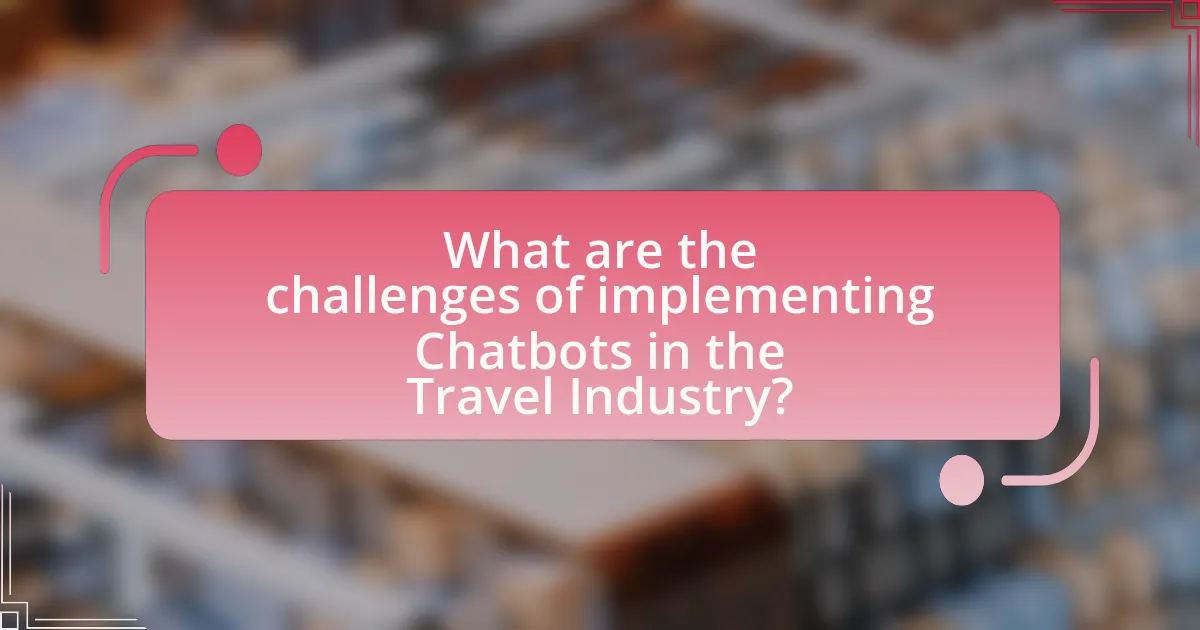
What are the challenges of implementing Chatbots in the Travel Industry?
The challenges of implementing chatbots in the travel industry include limited understanding of complex queries, integration with existing systems, and ensuring a seamless user experience. Limited understanding arises because chatbots often struggle with nuanced language and context-specific inquiries, which are common in travel-related questions. Integration challenges occur as travel companies typically use multiple platforms for bookings, customer service, and data management, making it difficult for chatbots to access and process information efficiently. Additionally, ensuring a seamless user experience is critical; if chatbots fail to provide accurate or timely responses, customer satisfaction can decline, leading to potential loss of business. These challenges highlight the need for advanced natural language processing capabilities and robust system integration to enhance chatbot effectiveness in the travel sector.
What common pitfalls do companies face when deploying Chatbots?
Companies commonly face several pitfalls when deploying chatbots, including inadequate understanding of user needs, lack of proper training data, and insufficient integration with existing systems. Inadequate understanding of user needs can lead to chatbots providing irrelevant responses, which diminishes user satisfaction. A study by Gartner indicates that 85% of customer interactions will be managed without a human by 2025, highlighting the importance of aligning chatbot capabilities with customer expectations. Lack of proper training data results in chatbots that cannot effectively handle diverse queries, leading to frustration among users. Furthermore, insufficient integration with existing systems can hinder the chatbot’s ability to access necessary information, limiting its functionality and effectiveness. These pitfalls can significantly impact the overall success of chatbot deployment in enhancing customer interactions in the travel industry.
How can businesses ensure Chatbots are user-friendly?
Businesses can ensure chatbots are user-friendly by implementing intuitive design, clear communication, and continuous user feedback. Intuitive design involves creating a simple and engaging interface that allows users to navigate easily, which can be achieved by following established UX principles. Clear communication is essential; chatbots should use natural language processing to understand user queries accurately and respond in a conversational tone. Continuous user feedback can be gathered through surveys and usage analytics, enabling businesses to identify pain points and improve the chatbot’s functionality. Research indicates that 70% of consumers prefer chatbots for quick communication, highlighting the importance of user-friendly design in enhancing customer satisfaction and engagement.
What measures can be taken to maintain Chatbot accuracy?
To maintain chatbot accuracy, regular updates and training on new data are essential. Continuous learning from user interactions allows the chatbot to adapt to changing language patterns and user preferences. Implementing feedback loops where users can report inaccuracies helps identify areas for improvement. Additionally, utilizing natural language processing techniques to enhance understanding of context and intent further increases accuracy. Research indicates that chatbots trained on diverse datasets perform better, as evidenced by a study from Stanford University, which found that models trained on varied conversational data improved response relevance by 30%.
How can companies overcome resistance to Chatbot adoption?
Companies can overcome resistance to chatbot adoption by implementing comprehensive training programs for employees and demonstrating the technology’s benefits through pilot projects. Training equips staff with the necessary skills to work alongside chatbots, alleviating fears of job displacement and enhancing user experience. Pilot projects allow companies to showcase successful chatbot interactions, providing tangible evidence of efficiency improvements and customer satisfaction. According to a study by Gartner, organizations that effectively communicate the advantages of automation see a 30% increase in employee acceptance of new technologies.
What strategies can be employed to educate customers about Chatbots?
To educate customers about chatbots, companies can implement interactive demonstrations, provide comprehensive FAQs, and utilize targeted marketing campaigns. Interactive demonstrations allow customers to experience chatbot functionalities firsthand, enhancing understanding and engagement. Comprehensive FAQs address common queries, clarifying the capabilities and benefits of chatbots. Targeted marketing campaigns can highlight success stories and use cases in the travel industry, showcasing how chatbots streamline customer interactions, improve response times, and enhance overall service quality. For instance, a study by Juniper Research indicates that chatbots can save businesses up to $8 billion annually by 2022, emphasizing their value in customer service.
How can businesses build trust in Chatbot technology?
Businesses can build trust in chatbot technology by ensuring transparency, reliability, and consistent performance. Transparency involves clearly communicating the chatbot’s capabilities and limitations to users, which helps set realistic expectations. Reliability is achieved through regular updates and maintenance, ensuring that the chatbot functions correctly and provides accurate information. Consistent performance can be reinforced by utilizing customer feedback to improve the chatbot’s responses and user experience. According to a study by PwC, 79% of consumers prefer to interact with a brand that is transparent about how it uses their data, highlighting the importance of trust in technology.
What best practices should be followed for effective Chatbot implementation?
Effective chatbot implementation requires a clear understanding of user needs and seamless integration with existing systems. First, defining the target audience and their specific requirements ensures that the chatbot addresses relevant queries and provides valuable assistance. According to a study by Salesforce, 69% of consumers prefer chatbots for quick communication with brands, highlighting the importance of user-centric design.
Next, utilizing natural language processing (NLP) capabilities enhances the chatbot’s ability to understand and respond to user inquiries accurately. Research from Gartner indicates that by 2025, 75% of customer service interactions will be powered by AI, emphasizing the necessity of advanced NLP for effective communication.
Additionally, continuous monitoring and optimization of the chatbot’s performance are crucial. Regularly analyzing user interactions helps identify areas for improvement, ensuring the chatbot evolves to meet changing customer expectations. A report by McKinsey shows that companies that actively refine their AI systems can achieve up to 20% higher customer satisfaction rates.
Lastly, providing a seamless handoff to human agents when necessary maintains customer satisfaction and ensures complex issues are resolved effectively. This hybrid approach, supported by a study from PwC, reveals that 59% of consumers feel companies have lost touch with the human element of customer experience, underscoring the importance of balancing automation with personal interaction.
How can travel companies continuously improve their Chatbot services?
Travel companies can continuously improve their Chatbot services by implementing regular updates based on user feedback and analytics. By analyzing customer interactions, companies can identify common issues and areas for enhancement, allowing them to refine the chatbot’s responses and functionalities. For instance, a study by Salesforce found that 69% of consumers prefer chatbots for quick communication with brands, highlighting the importance of efficiency and accuracy in chatbot interactions. Additionally, integrating advanced technologies such as natural language processing and machine learning can enhance the chatbot’s ability to understand and respond to diverse customer inquiries, further improving user satisfaction.
What metrics should be tracked to evaluate Chatbot performance?
To evaluate chatbot performance, key metrics include user engagement, response accuracy, resolution time, and customer satisfaction. User engagement can be measured by tracking the number of interactions and session duration, indicating how effectively the chatbot captures user interest. Response accuracy assesses the percentage of correct answers provided by the chatbot, which is crucial for maintaining trust and reliability. Resolution time measures how quickly the chatbot resolves user inquiries, impacting overall efficiency. Customer satisfaction can be gauged through post-interaction surveys, providing direct feedback on user experience. These metrics collectively offer a comprehensive view of chatbot effectiveness in enhancing customer interactions in the travel industry.










